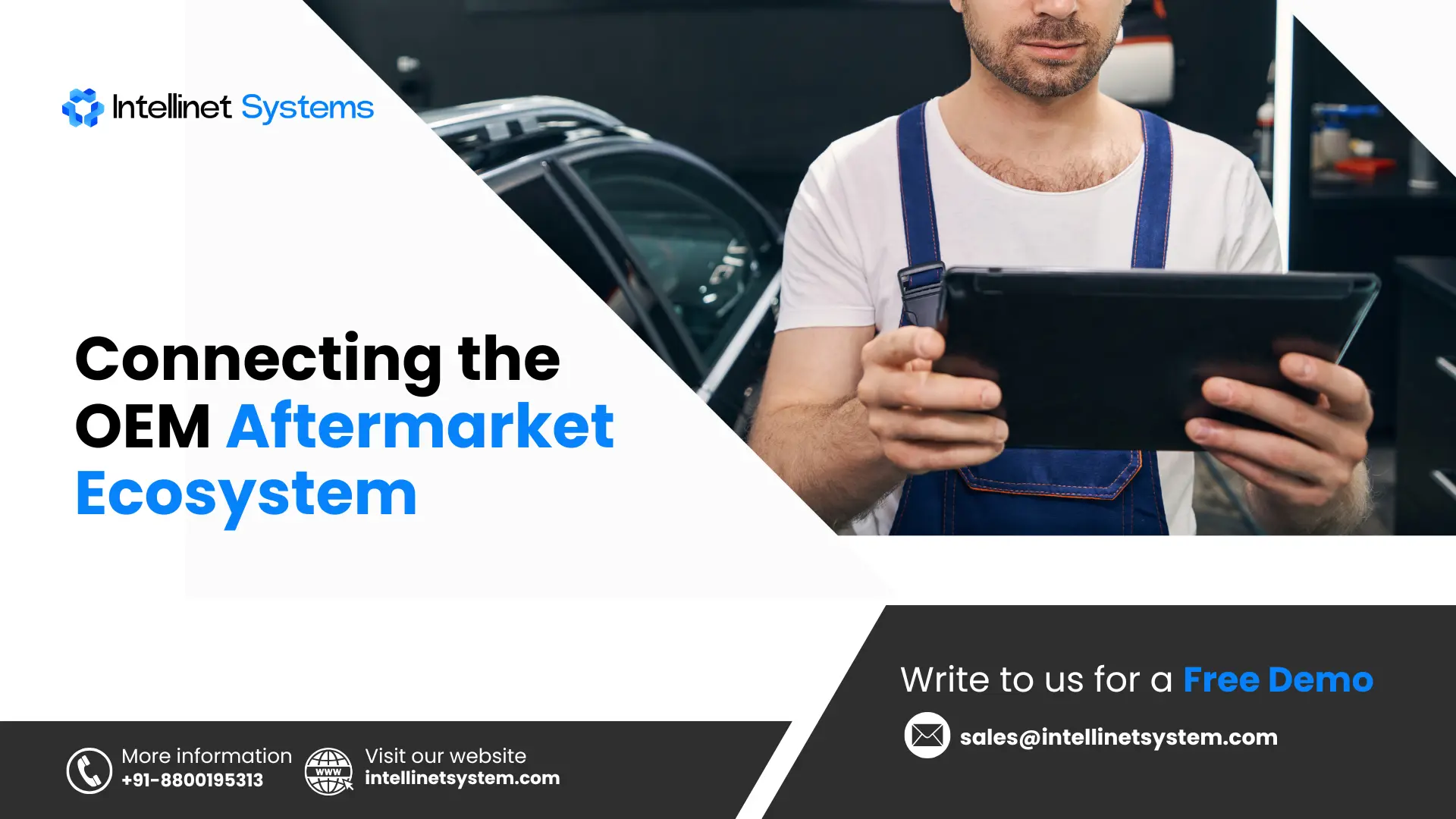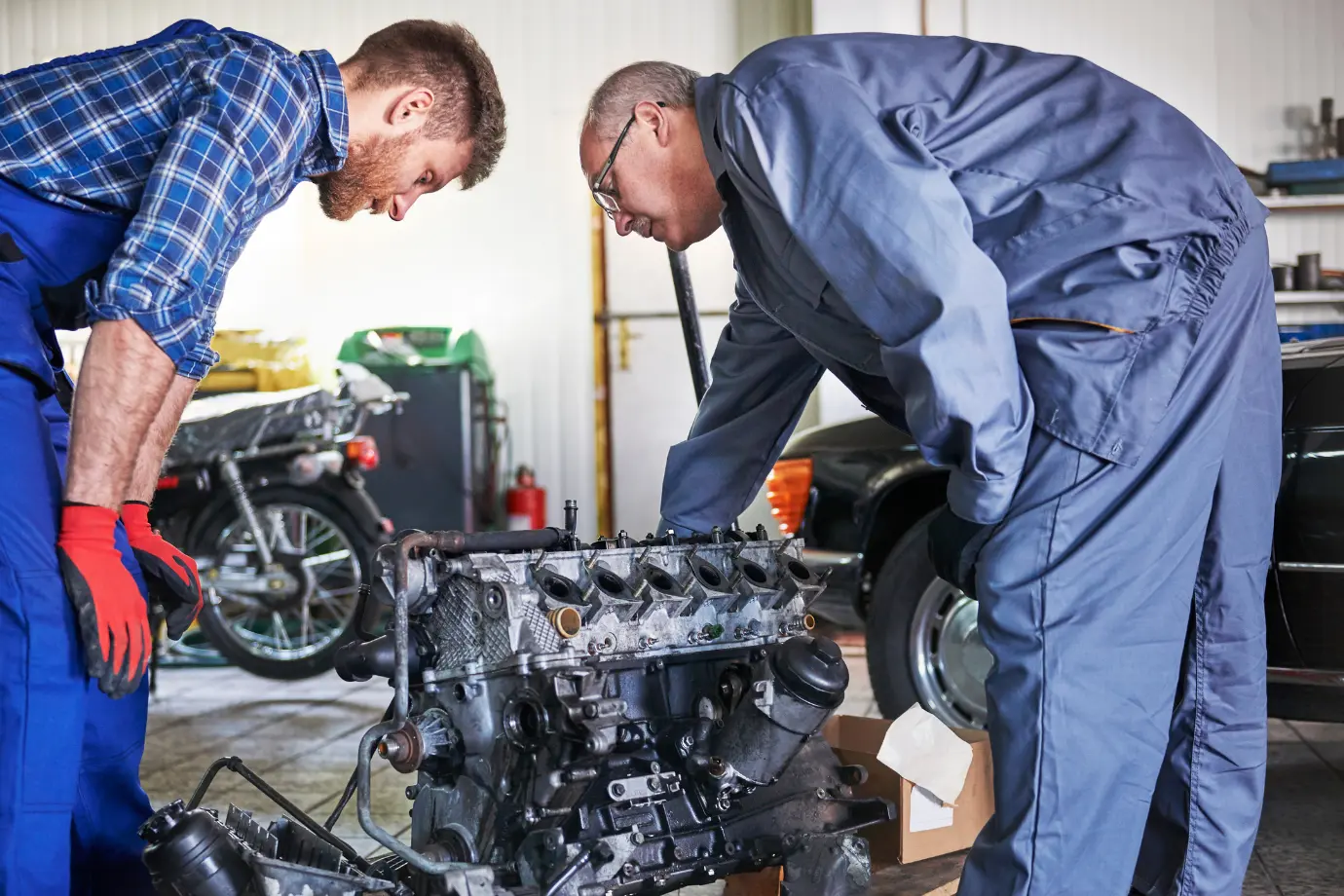
Until a few decades ago, the aftermarket was a battleground for Original Equipment Manufacturers (OEMs) that involved chaos and a daily test of everyone’s sanity. The concept of a connected aftermarket ecosystem has turned that mess into an opportunity.
Connected aftermarket ecosystem is a unified platform that brings together OEMs, dealers, customers, and technologies like IoT and AI to deliver aftermarket solutions to streamline service lifecycle management. With aftermarket often driving a significant share of an OEM’s revenue, the stakes are enormous. Customers want fixes immediately, and third-party vendors are circling, ready to snatch your share if you stumble.
This blog explores why OEMs need a connected aftermarket ecosystem, breaks down its key components, and reveals how it can turn your business into a market leader. Keep reading, this is your roadmap to making the aftermarket your competitive edge.
Why Do OEMs Need a Connected Aftermarket Ecosystem?

The aftermarket was the chaotic, essential, but frequently overlooked component in the early days. The real pain OEMs face in the aftermarket includes siloed operations, manual processes, and poor customer experiences. However, the aftermarket is now the main attraction, generating loyalty and profits more than anything else. An interconnected aftermarket ecosystem enables OEMs to provide prompt and proactive services as demanded by customers.
Aftermarket services may account for as much as 50% of total profits; therefore, slow systems and fragmented data become silent but deadly shortcomings. When a business's warranty system isn't in sync with its parts inventory, it costs them millions of dollars every year, leaves dealers in a drift, and frustrates customers. By knitting together service lifecycle management with the latest technology, OEMs can serve up tailored services that keep customers hooked.
This isn't simply a technical solution for OEMs; it's an opportunity to outperform competitors, fend out third-party vendors, and solidify long-term customer retention tactics. In a market where every slip costs you, a connected ecosystem is your lifeline.
What Factors Led to the Need for this Connectivity?
This high-stakes game did not develop naturally in the aftermarket. A linked ecosystem became non-negotiable due to a number of factors, including operational challenges and changes in the market. Let's understand these factors below:
1. Constantly Switching Between Tools
In the past, service teams struggled with distinct systems for parts, warranties, and repair guides due to the lack of interaction across aftersales modules. In the absence of integrations, teams have access to isolated information, which often leads to misplaced orders. In order to check a warranty, a dealer will need to switch to a different model, which wastes time and leads to mistakes that annoy customers.
2. Mismatched Interfaces for Every Module
Each system, whether it managed parts, warranties, or services, had a distinct interface, as it had been assembled by disparate teams of people who never spoke to one another. Service managers often struggled to get through their day by navigating several cumbersome displays. It wasted time and was a breeding ground for mistakes. To streamline training and increase productivity, businesses require a single, clear interface.
3. Growing Demand for Smarter Services
Individuals started asking for real insights, such as when to service their vehicle based on the usage pattern. Without a single place to fetch data, companies were stuck, allowing the opportunity for competitors to grab their spotlight. They had to figure out how to use sensors and analytics to give customers valuable, on-the-spot advice that helped.
4. Remote Monitoring for Complex Equipment
As machines got trickier, breakdowns hit harder. Without real-time data, teams struggled to diagnose equipment issues, leaving customers stuck. They needed sensors tied to service systems to spot trouble early and fix it before it became a disaster.
5. Preventing Breakdowns Before They Happen
Customers were done waiting for stuff to break; instead, they wanted machines that kept running. Predicting something like a pump failure required digging into data from all sources. That push for a smooth, scalable service setup that crunches numbers fast forced OEMs to connect all systems and keep everything running smoothly.
6. Support ‘As a Service’ Business Models
With time, ‘as a service’ models are flipping the aftermarket on its head. Businesses today are offering ‘uptime-as-a-service,’ guaranteeing 98% equipment availability for a monthly fee. According to industry reports, these models can boost OEMs’ revenue by up to 19%. They fit customers’ hunger for flexibility, for they now want performance guarantees and not just repairs anymore. This made it necessary to have a streamlined aftermarket system that provided access to all the data for a broader outlook.
7. Better Customer Experience
Consumers were fed up with delayed, inconsistent service, such as having to wait days to get a repair done. When businesses are unable to keep customers informed, they may lose a significant number of sales. People wanted clear, instant updates, preferably through an online portal. That required combining customer information, sensor data, and service records for a smooth and personalized feel.
These drivers tackle the real pain OEMs face in the aftermarket. A connected ecosystem organizes the data, slashes costs, and boosts customer retention, giving OEMs the edge to dominate. The goal is to turn setbacks into wins and ensure their aftermarket prospers rather than just survive.
How Does a Connected Aftermarket Ecosystem Work?

Similar to a high-performance engine, a connected aftermarket ecosystem requires flawless integration between all of its components. Here’s the breakdown of its essential components, each critical for delivering aftermarket solutions that hit the mark.
Connection to Assets and Customers
Keeping your customers and equipment in sync is the first step to a connected environment. IoT sensors ping alerts before a breakdown leaves the driver stuck. By using Artificial Intelligence (AI) to predict when a jet turbine blade could fail, predictive maintenance takes it to the next level and saves a significant amount of money on downtime.
When OEMs estimate such failures properly, repair costs can be lowered by 10%. On the customer's side, CRM systems are like a reliable companion that keeps them satisfied. OEMs can reduce complaints greatly just by informing customers when a repair is scheduled. CRM, forecasting, and monitoring bring everything together, aligning your equipment with what customers require to maintain seamless operations and high customer loyalty.
Coordination of Service Delivery
Providing services correctly is a challenging and untidy undertaking. The first step is to establish clear processes that outline processes to prevent a repair from turning into chaos. A disorganized OEM servicing procedure might result in stuck repairs and lost revenues. From dealers to technicians, everyone accesses the same information when everything is connected.
Then there’s getting the right people and parts where they’re needed. OEMs can reduce delays simply by aligning technicians' schedules with their parts inventory. Additionally, even an inexperienced mechanic can successfully execute a complex repair by following step-by-step instructions from a cloud system. Coordination like this maintains the service chain tight, ensuring that repairs are completed quickly with minimal errors, and OEMs are not burdened with minor details.
Execution of Service Work
This is where the action happens. Field service tools provide technicians with the necessary equipment to work. These days, IoT systems provide them with exactly what they need, cutting downtime significantly. Spare parts management ensures components aren’t rotting in a warehouse. By matching parts to service requirements, OEMs save thousands of dollars annually.
When systems are interconnected, warranty claim processing becomes simple and resolution times are shortened, preventing a month-long dispute over a defective item. The return management system manages returns flawlessly, with faulty products being sent back to suppliers quickly and reducing disputes. This connected flow keeps equipment functional and customers coming back.
Data-Driven Optimization
A linked ecosystem depends on data to function effectively. Pulling insights from sensors, service logs, and customer complaints turns raw data into a valuable resource. By analyzing consumption trends, OEMs may adjust schedules and reduce maintenance expenses. Tracking things like uptime or repair speed spots weak spots fast, enabling OEMs to boost efficiency by catching hindrances in real time.
But it's not a one-and-done affair either; the key is to use data to continuously adjust procedures. By adjusting workflows based on analytics, OEMs can extend the life of their equipment significantly. This data backbone ties assets, services, and customers into a loop that keeps getting better, helping OEMs stay lean, profitable, and a step ahead.
How Intellinet Systems Facilitates OEMs in Building a Connected Aftermarket Ecosystem?

A leader in aftermarket solutions, Intellinet Systems equips OEMs in several industries to build connected ecosystems. Our cloud-based solutions, driven by intelligent AI, reconstruct the entire aftermarket system, address inefficiencies, and improve customer experiences.
Intellinet Systems is on a mission to change the hassle involved in siloed aftermarket systems, especially for fast-moving sectors like automotive, electric vehicles, aerospace, and heavy machinery. With a proven track record of serving global OEMs and earning industry awards, our software hands OEMs a playbook to turn scattered, inefficient service chains into a tight, connected ecosystem.
Here is how OEMs looking to modernize their aftermarket benefit from our solutions:
Intelli Catalog
Intelli Catalog transforms parts management by creating a unified electronic catalog for B2B, B2C, and B2B2C models, slashing order errors considerably. So, how does it fuel a connected ecosystem? By acting as a central hub that syncs parts data across the aftermarket chain, dealers, distributors, suppliers, and service teams all access the same real-time inventory details. It is a resolute choice for OEMs with networks where dealers used to spend hours hunting for spare parts in fragmented systems.
Intelli Catalog’s cloud-based platform integrates with warranty and service modules, ensuring a part ordered in the field reflects instantly in the service schedule and inventory counts. This connectivity eliminates delays, aligns OEM’s service lifecycle management goals, and ensures dealers and customers get what they need fast, keeping operations smooth and loyalty intact.
Intelli Warranty
Processing warranty claims used to be a nightmare, dragging on forever. In teams where warranty data is isolated from parts and service data, claims processing may often get stuck. Intelli Warranty changes all that, acting like a bridge that ties claims to the bigger picture. Its AI pulls live data, so when a faulty part pops up in the field, it pings the supplier for recovery, updates service logs, and keeps customers in the loop with clear updates. By keeping everything linked and flowing quickly, it can reduce claim waits, stop fraud in its tracks, and build trust among dealers and customers.
Intelli Manual
Intelli Manual replaces outdated PDFs with AI-powered, interactive documentation, speeding repairs. It builds connectivity by putting real-time, context-aware guidance at the center of the ecosystem. Intelli Manual’s cloud-based system delivers customized instructions, complete with text-to-speech and visuals, right to the technician’s device. By syncing with service and parts systems, it ensures the repair aligns with inventory and schedules, cutting errors and tying service lifecycle management into a unified entity.
Intelli Desk
Intelli Desk is like the epicenter for sorting out field issues, turning a mess of complaints into a slick, connected tool that keeps the aftermarket humming. I once saw an aerospace company tank a big client relationship because a turbine problem got lost in a tangle of back-office emails, leaving the fix delayed and trust in tatters. Intelli Desk fixes the communication gap by pulling dealers, service managers, office teams, and suppliers onto one platform. You log a report with a serial number or VIN, and it shoots straight to the right manager for quick action.
Meanwhile, detailed reports pile up data for the back office to dig into, generating training plans or notifying suppliers to stop the same problem from popping up again. The transaction color master flags tasks based on urgency, making sure the big stuff gets handled first and reducing 20% of the wait time. OEMs get a clear view with reports on how fast things are moving or where bottlenecks are, and there’s a shared knowledge base that lets dealers handle repeat issues without calling for backup. By tying into warranty and inventory systems, Intelli Desk keeps workflows tight, analytics sharp, and expertise flowing, making dealers more efficient and products more reliable.
Intelli PDI
Pre-delivery inspections were a common ground that sparked conflicts between OEMs and dealers when defects slipped through. OEMs in fast-moving industries like automotive often get hit with recalls because their systems remain disintegrated. Intelli PDI, a mobile-based inspection tool, catches issues early, cutting disputes by nearly a third. It connects quality checks to the whole aftermarket chain; for example, if a defective brake part is detected, real-time action is taken to schedule services and recover the supplier. It works on preventing defects and errors before delivery, saving money, and building customer trust right from the first mile.
Intelli RMS
Intelli RMS is the unsung hero of warranty parts return management, streamlining the messy process of handling defective parts across the globe. It builds a connected ecosystem by linking return centers, dealers, suppliers, and logistic carriers into a single, transparent platform. Intelli RMS automates workflows, from generating return requests with digital images to tracking shipments with carriers like FedEx or UPS.
By integrating with warranty and parts systems, it ensures a defective part’s return request syncs instantly with inventory updates and supplier recovery claims, cutting turnaround times and reducing administrative troubles. This connectivity ties service lifecycle management into a closed loop and boosts efficiency with fast, transparent service.
These aftermarket solutions ensure OEMs’ aftermarket operations function smoothly and set the stage for a future where the aftermarket isn't an afterthought but rather a competitive advantage.
Intelli DVR
As a dealer auditing powerhouse, Intelli DVR transforms cumbersome, paper-based audits into a data-driven hub for an interconnected aftermarket setting. Earlier, manual audits took weeks and resulted in gaps in compliance and service quality, and OEMs often faced trouble with variable dealer performance. This is revolutionized by Intelli DVR, a modern and efficient dealer-auditing software. Its mobile and web applications enable auditors to record real-time data, such as images and videos, using checklists that can be customized to OEM specifications.
By providing instant insights into dealer performance, its outputs, such as detailed audit reports in Excel, PDF, or SSRS formats, and analytics dashboards, reduce audit times by 30%. Through integration with warranty and service systems, it ensures that noncompliance is addressed through timely corrective actions, such as focused training, promoting transparency throughout the dealer network. OEMs' aftermarket strategy is driven by this connection, which also gives them access to real-time KPIs that help in improving brand consistency, streamlining operations, and increasing customer retention strategies through a more insightful and accountable dealership chain.
Business Benefits for OEMs

A well-connected aftermarket ecosystem yields benefits that appeal to the profitability, efficiency, and growth of every OEM. Here’s why it’s worth your time:
Reduced Downtime
Predictive maintenance and remote monitoring slash downtime by 20%. OEMs may be able to save millions by catching failures early with IoT diagnostics. Intelli Desk and Intelli PDI streamline fixes and quality checks, keeping equipment operational.
Improved Product Performance
Data-driven insights boost performance. Predictive maintenance extends asset life by 15%. Intelli Manual and Intelli Catalog ensure spot-on repairs and improve the brand’s reliability.
Enhanced Customer Relationships
Personalized customer experiences, like real-time service alerts, drive loyalty and boost repeat business by 20%. Intelli Warranty and Intelli Help Desk deliver seamless interactions, strengthening customer retention.
Competitive Advantage
A connected ecosystem sets OEMs apart. Intellinet Systems' aftermarket solutions help snag market share, which translates to a significant revenue boost. It aligns with OEM aftermarket strategy, making you a leader.
Conclusion
The aftermarket was a total mess where dealers struggled, customers flared up, and profits slipped through the cracks. OEMs used to lose revenue because even the simple repairs got stuck in a tangle of outdated systems. But now, players like Intellinet Systems have come up with aftermarket solutions that help you turn that chaos into a profit trove.
A connected aftermarket ecosystem backed by tools like Intelli Catalog and Intelli Warranty keeps your service chain tight, customers happy, and revenue climbing. This isn’t just about making ends meet; it’s about owning the aftermarket, outsmarting competitors, and keeping customers coming back for more.
To take a free demo on how Intellinet Systems can assist in building an aftermarket ecosystem for your business, connect with our experts today.
Explore More Insights
About the Author
Chandra Shekhar
Chandra Shekhar is the Senior Manager, Strategy & Business Development at Intellinet Systems. With over a decade of experience in the automotive industry, Chandra Shekhar has led digital transformation and aftersales strategy initiatives for OEMs across multiple markets. His background combines deep industry knowledge with a practical understanding of how technology can solve real operational challenges. He focuses on making complex ideas clear and relevant for automotive and aftermarket professionals navigating ongoing change.



























